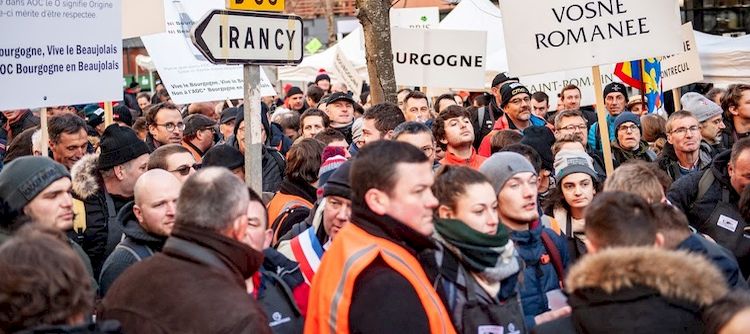To stay up-to-date with the BIVB, subscribe to news alerts
 Press releases
Press releases10/02/2020

Some 450 winegrowers joined forces on 6 February to protest outside the headquarters of the Institut National de l’Origine et de la Qualité (INAO) in Montreuil, just outside Paris. This unprecedented protest had the full backing of the region’s parliamentarians, along with the presidents of regional and departmental councils.
The INAO has now announced it is reversing its decision to remove 64 Bourgogne communes from the Bourgogne AOC production area and is seeking talks.
Representatives of Bourgogne winegrowers remain cautious, however, as there is still plenty of work to do to defend the notion of place of origin and the identity of Bourgogne wines as a whole.
Fewer than three weeks after the INAO announced its plans, 450 winegrowers from all over Bourgogne gathered in the early hours in front of the INAO headquarters to protest their dissatisfaction whilst ensuring a certain conviviality. The demonstration followed a series of meetings attended by around 800 winegrowers and the creation of a petition that has already gathered more than 6,000 signatures:
Members of Parliament from all parties, the President of the Bourgogne-Franche-Comté Region, the Presidents of Departmental Councils, and Mayors from winemaking villages all threw their support behind the action and were received by the INAO’s Wine Committee President Christian Paly, along with representatives of the Bourgogne wine trade.
U-turns, promises, and dialog from the INAO, but many questions remain
The INAO has now scrapped its plans to exclude 64 communes from the Bourgogne AOC production zone, located in Chablis, Dijon (the capital of the Bourgogne region), the Châtillonnais, and elsewhere in the region. Obviously, this must be translated into new proposals for defining the area covered by the AOC, and dialog is beginning with the Institute, even if it may currently seem difficult to envisage finding common ground with the INAO’s same commission of inquiry.
A new commission of enquiry, capable of supporting these changes of position and perspective, would seem indispensable in order to ensure this work is carried out successfully.
Another major issue is that so far, nothing has been resolved in terms of respecting the identity of the Bourgogne appellation. The stakes remain high for all Bourgogne appellations, with serious potential economic consequences and a real threat of production relocation. Diluting the Bourgogne AOC with the inclusion of another winegrowing region would contribute to discrediting the very notion of appellation of origin.
Maintaining this pressure and remaining vigilant is now key across the entire Bourgogne winegrowing region.
Follow on the social medias with:
#leBourgogneenBourgogne